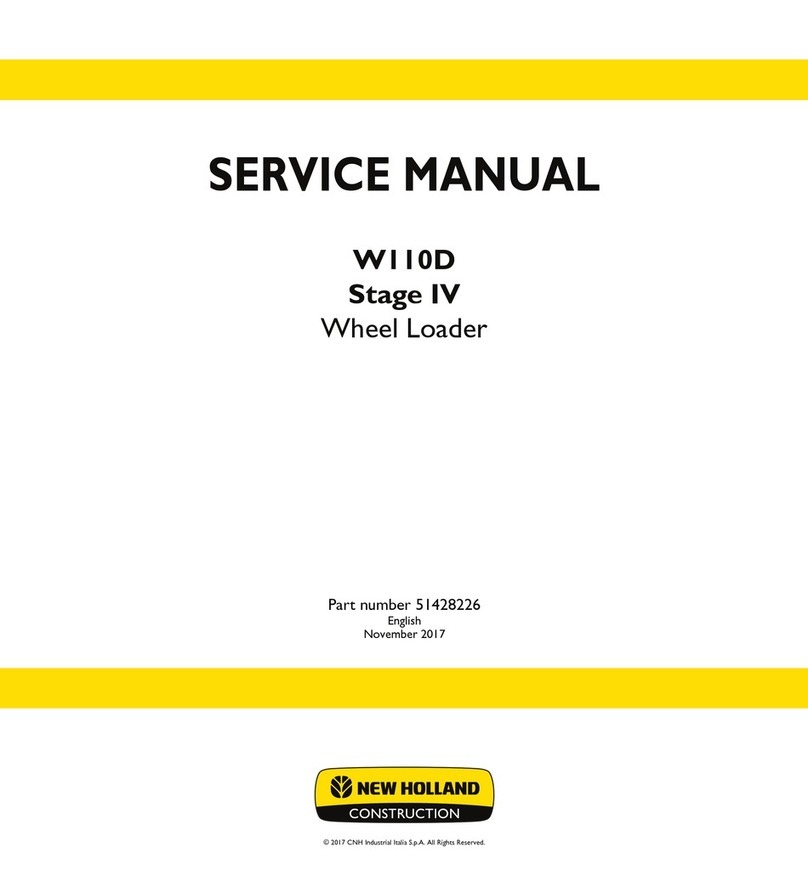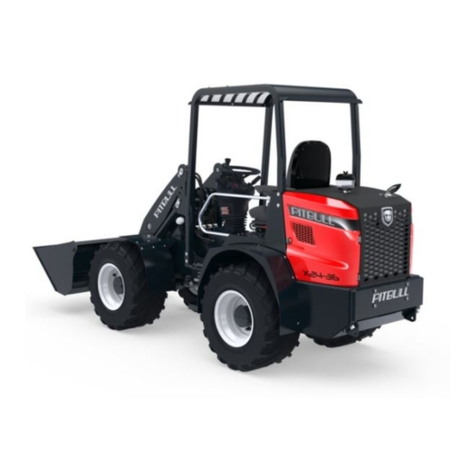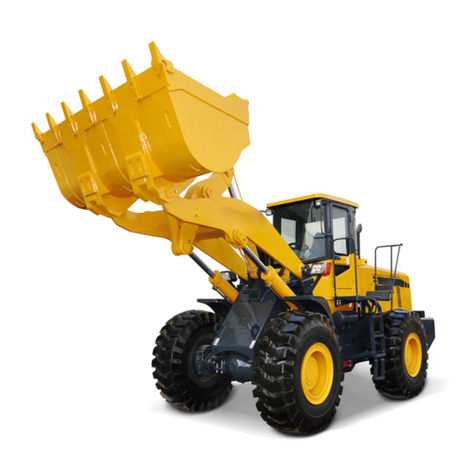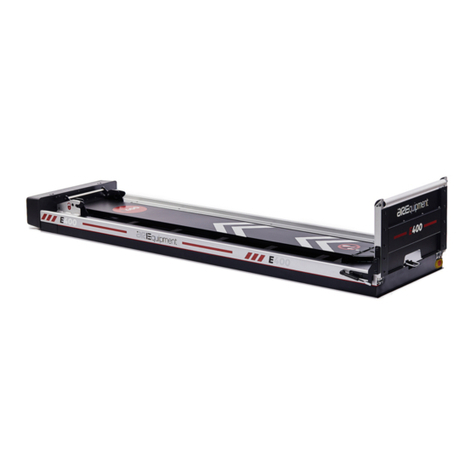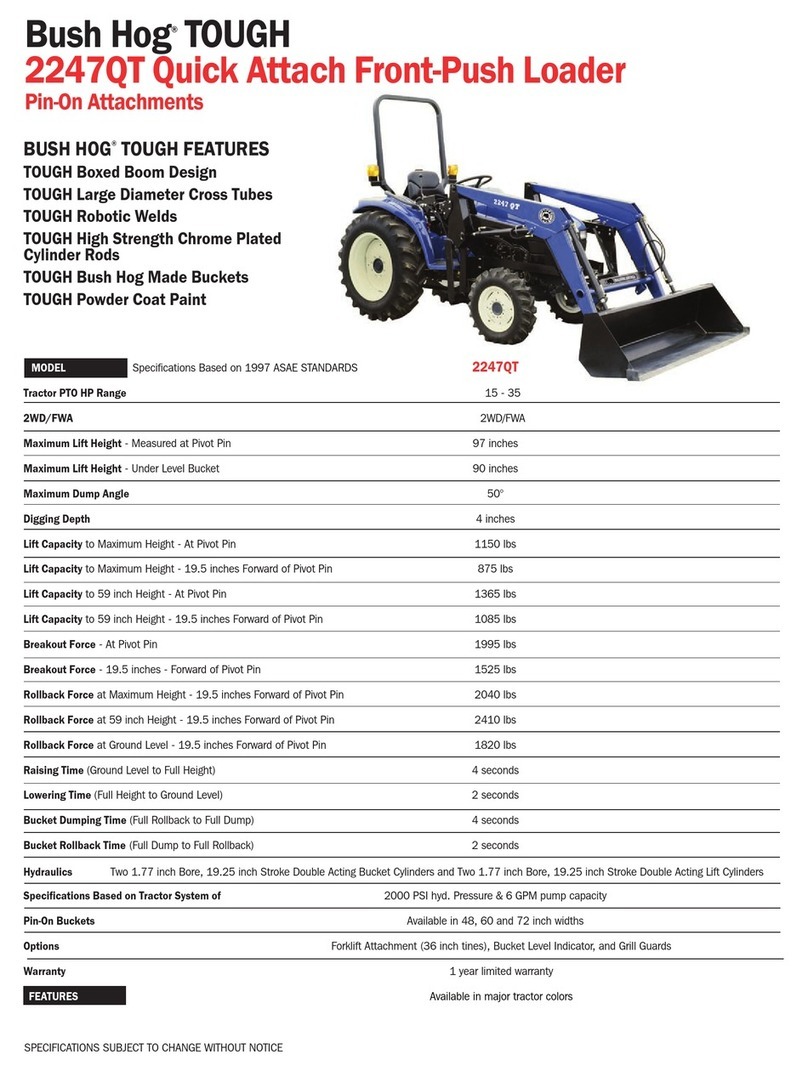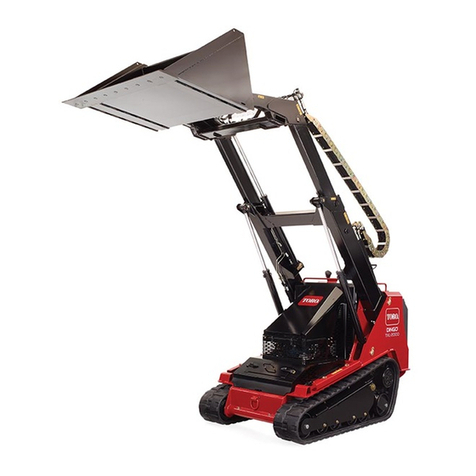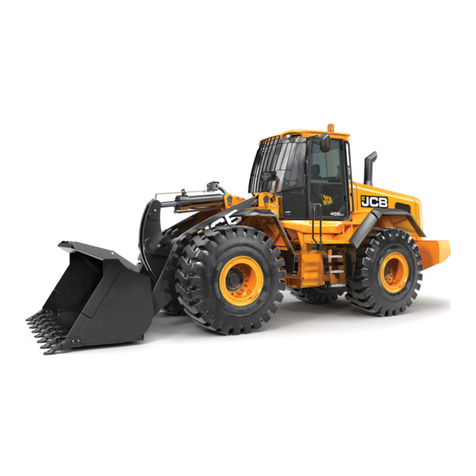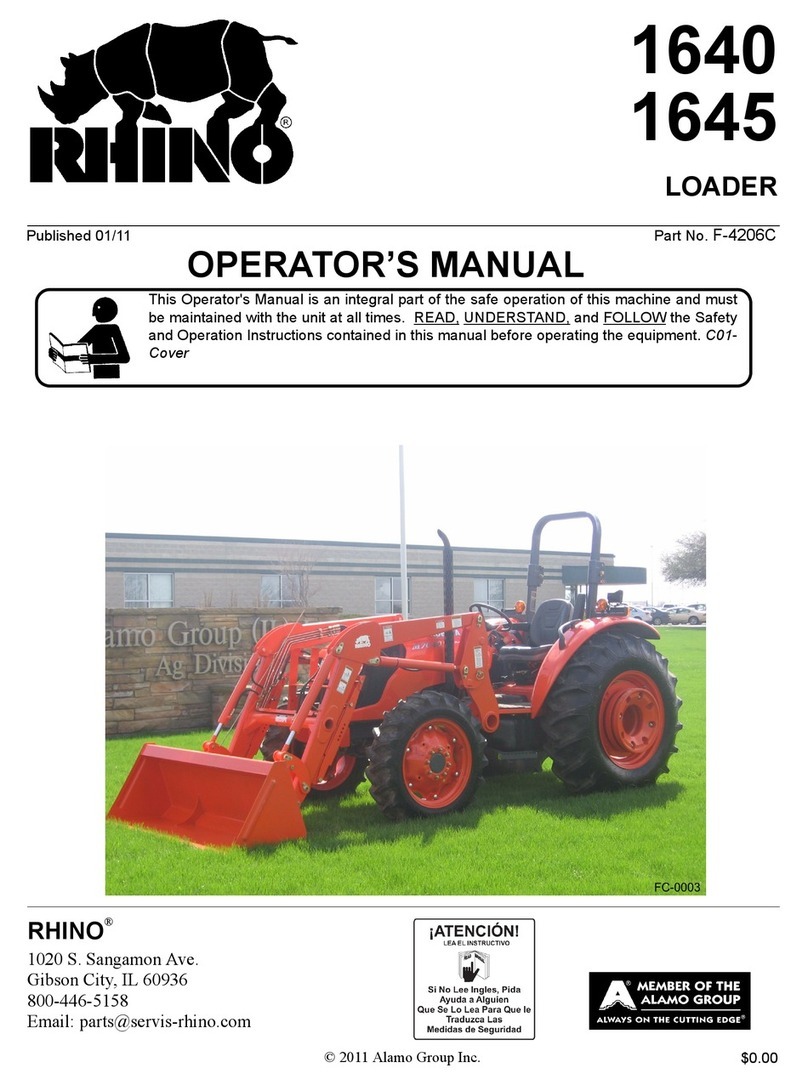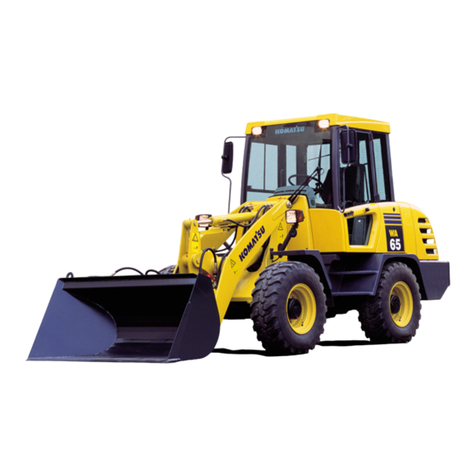EVERUN ERT1500 User manual

Everun Telescopic Loader
Operation Manual
ERT1500
Qingdao Everun Machinery Co., Ltd.

01
FOREWORD
Thank you for choosing this
Compact
rough terrain
forklift
with horizontal arm(hereafter“fork-
lift”),
which offers the best levels of performance, safety
and
working comfort.
Remember
that“you”are
the key to maintaining these characteristics. Correctuse of the forklift will enable
you to take
full
advantage of the features
it
has to offer.
You
should read and under stand this Manual be fore operating the
forklift.Its
purpose
is
to pro-
vide instructions for those persons
in
contact with the machine and especially for the machine’s
operator.
Its
content
will
help you to better understand the
forklift,
and teach
all
you need to
know
about starting
it,
driving techniques
,
maintenance and care
,
designed uses of the
forklift
and
safety instructions to be followed.
WE
is
continually improving
its
products and reserves the right to
make
such improvements
with-
out incurring any obligation to make changes to forklifts previously sold. Therefore, claims
cannot
be
made
based on the data,
illustrations
and descriptions set forth in this manual.
Use only original spare parts. Only thus can you guarantee that the forklift will continue to give the
same
level of technical performance as
when
purchased.
No
changes should
be made
to the forklift without prior authorization from the manufacturer.
Store the manual with care, including after having fully re
ad
the document,to ensure that you
can
refer to
it
in the future and clarify any doubts
.
Should you have any difficulty understanding
this
manual, or any paragraph in the manual, contact your Official
ERT1500
Representative
orDealer.

02
INTRODUCTION
The manual consists of five sections:
Section 1
:
GENERAL INFORMATION
Section
Section 2
:
SPECIAL SAFETY INFORMATION
SectionSection 3
:
OPERATING INSTRUCTIONS
Section 4
:
PERIODIC MAINTENANCE OPERATIONS
Section
Section
5
:
DIAGRAMS AND CHARTS
Section 1,
“GENERAL INFORMATION”,
includes general information on the main parts
of the
machine. This section also lists details of part references and technical characteristics, etc.
Section
2,
“SPECIAL SAFETY INFORMATION”,
is
aimed at personnel
in
charge of the
correct
operation of the machine, repairs and maintenance, and, for companies with a
large number of
machines, the safety manager.
This section also includes the requirements which managers must satisfy and key items of
indispensable safety information.
Section
3,
“OPERATING INSTRUCTIONS” mainly targets operators. This section
illustrates all
control devices and instruments and includes
instructions
on how to use the
forklift:
from starting the engine, to parking and leaving the
forklift.
Section 4, “PERIODIC
MAINTENANCE
OPERATIONS”, mainly targets operators, and
specificallythe maintenance manager and personnel. This section includes information on the
planned
maintenance program, the regularity of operations, which liquids and lubricants to use,
greasing
points, etc.
Section
5,
“DIAGRAMS AND CHARTS”
includes tables
and
related
documents: load
charts,wiring and hydraulic diagrams, etc.

03
NOTE
Should conflict be identified between the content of this manual and the actual operation of the
machine, this may be due to the manual relating to a more recent version of the machine or to
themanual not having been updated since modifications to the machine.
In this case, contact your Official ERT1500 Representative or Dealer to clarify any doubts or obtain
another version of this manual.
Optional equipment is indicated as follows: (if fitted).
Optional equipment
will
only be supplied at the express request of the customer, for
specificversions or countries.

04
Indicates situations which,
if
the appropriate safety precautions are not taken for yourself and
others, imply serious risks for the physical integrity of the people involved, and
may
even include a
risk of death.
DANGER
Indicates situations which,
if
the appropriate safety precautions are not taken for yourself and
others, imply serious risks for the physical integrity of the people involved, and
may
even include a
risk of death.
ELECTRIC HAZARDS
Indicates situations relating to your safety and that of others, which imply low risks
of accidents or
injury, or the ineffective operation of the machine
WARNING
The text following this symbol includes information on recycling and environmentalinformation.
ENVIRONMENTALPROTECTION
SYMBOLS
Should conflict be identified between the content of this manual and the actual operation of the
machine, this may be due to the manual relating to a more recent version of the machine or to
themanual not having been updated since modifications to the machine.
In this case, contact your Official ERT1500 Representative or Dealer to clarify any doubts or obtain
another version of this manual.
Optional equipment is indicated as follows: (if fitted).
Optional equipment
will
only be supplied at the express request of the customer, for
specificversions or countries.

05
HOW TO IDENTIFY YOUR MACHINE
1.
MACHINE DIRECTIONS
The
terms right, left,
forward and
back,
when
used in this manual, refer to these positions from the operator’s seat
looking forwards. These references will
be
particularly useful to identify the differ-ent machine parts(front, rear, etc.)
mentioned
in this manual.
2.
WARNING PLATES AND LABELS ON THE MACHNE
IMPORTANT:Take time to learn these plates and labels. Check that they are readable. Clean and replace
damaged
or unreadable (text or graphics) items.Use a clean cloth, water and soap to clean plates and labels.
Do
not use solvents, gasoline, etc. Should a plate or label be placed on a compo- nent to be replaced, check that the
plate or label is transferred to the
new
component.

15
HOW TO IDENTIFY THE MACHINE
IMPORTANT:
Check
that the instructions
manual
is
the right version for the
machine
in question.Please indicate
model number,
date of
purchase and frame and
serial
number when
consulting
ERT1500
or your dealer
for
any
matter. This information
can be found on
the identification plate.
We recommend you make
a
record of these
numbers
in the
spaces
provided
below
for
handy
reference
and keep
it
in your
files.
1.
IDENTIFICATION PLATES
·MACHINE IDENTIFICATION PLATE
Located inside the cab, to the right of the driver.
This plate
mentions information such as themachine
model,frame number,engine number,year of
manufacture, etc
Identification plates of the main components
Plates for
all
components which are not
directly
manufactured
(e.g.:
engines, pumps,
etc.) will
be
directly
attached to these components at the points where the respective manufacturers had
originally
located the
plates.
·ENGINE NUMBER
The
engine
number
is
marked on
the right
hand
block under the exhaustcollector
box
and on
a label
on
the upper part of the valve cover.

12
ACCEPTABLE USE
The Compact
off-road forklifts have
been
designed
and
manufactured to lift,handleand transport agricultural
and
industrial products via accessories
and
equipment manufactured or authorized by
EVENRUN.
This does not
include the following:
-
Suspended loads. Should the
forklift
be used to carry suspended loads, take the appropriate
precautions or
consult an authorized dealer.
-
Lifting people. Should the forklift be used to lift people, obtain information on applicable legisla
tion as per each
country and take the appropriate precautionsor consult an authorized
ERT1500
dealer.
Any other use should be considered outside of the intended use and therefore improper.
Close adherence to the operation, maintenance and repair conditions specified by the manufacturer is
essential for good use of this machine.
Driving, maintenance and repair of the
forklift
must only be entrusted to duly trained personnel,who have the
required tools and know the intervention and safety procedures relating to the fork-
lift.
Health and safety at work and risk prevention standards should be respected during
all
transport, maintenance or
repair operations.
When
driving on public roads
current legislation must be adhered to (Highway code).
CAUTION
INo modifications or other interventions of any type
may
be carried out on the machine, with the
exception of repairs and maintenance. Should the machine be handy reference and keep
it
in your
files.
modified any way without the authorization an
Official
Representativeor Dealer, this
will
automatically
nullify
compliance of the machine.
Improper use
is
understood to be the use of the
forklift in
such a way that
it
does not meet withthe
criteria
and
instructions of
this
manual and
in
such a way that said use
may
cause harm to persons or equipment.

13
DANGER
The following are some of the most frequent and dangerous
instances of improper use:
-
Carrying people on the forklift or an accessory or item of equipment.
-
Lack of strict compliance with the instructions for use and maintenance set out in this manual.
-
Exceeding load limits for the forklift.
-
Working on unstable, unconsolidated ground or on the edge of ditches and trenches.
-
Operating crosswise on slopes.
-
Working during storms.
-
Operating on slopes steeper than recommended.
-
Using accessories or equipment for purposes other than those intended.
-
Using accessories or equipment not authorized or manufactured by ERT1500.
-
Operating in locations with a risk of fire or explosions.
-
Operating in confined or unventilated locations.
PERATOR RISKS
Certain risks could be caused by operators during their work. For example:
-Risks caused by working excessively fast or carrying loads at excessive heights in view of theload or working
environment.
-
Risks caused by applying methods incorrectly when controlling or replacing a hydraulic valve(residual
pressure
-
uncontrolled movements).
-
Risks
caused by
applying
methods
incorrectly
when
dismantling parts such as e.g. cylinders
without
having attached all mobile parts appropriately (risk of mobile parts accidentally falling).
-
Risks caused by the machine accidentally tipping over without use of the seatbelt.

14
4
5
3
2
1
6
9
MAIN PARTS
1
- bucket
2
- Fork carriage for accessories and tools
3
-
Horizontal arm
4 - Headlights and signal lights
5
-
Engine cover
6
-
Wheel
7
- Driver’s seat with seat belt
8 - Steering wheel
9 - Front axle

15
DESCRIPTION OF THE MAIN PARTS
1.
HYDROS TATICTRANS MISSION
This
is
an assembly of components enabling the movement of the machine. Theassembly mainly consists
of:
-variable-flow hydrostatic pump connected to the combustion engine via an elastic coupling.
-
a hydraulic unit fitted on the differential pinion of the front axle.
-
two
radial piston hydrostatic motors,
one on each
wheel, for the rear axle.
A
solenoid valve which ensures differential
blocking,
and can be
selected using a button
on
the lower part of the joystickhandle (only
on
4WD
versions).
-
a hydraulic fluid filter in the tank suction line.
-
a cooler for the hydraulic oil circuit
2.
FRONT AXLE
The front axle transmits the movement from the hydraulic unit to the wheels
3.TYRES
The machine
is
equipped with tyres with the appropriate dimensions for the maximum load accept-
ed on the
forklift.
Should tyres be changed, systematically replace them with tyres with the same dimensions and
load carrying
properties.
4.
THE PARKING BRAKE is a negative system and actuates the disk assembly of the servicebrake
(hydraulic actuation).
This brake is activated using a switch located to the left of the instrument panel, facing theoperator.
5.
TOWING HOOK (IF FITTE D)
The machine may be
fitted
with a rear connection and
pull
authorized
trailers.
·Check if your machine is equipped with optional accessories

16
DURATION OF USE
Certain risks could be caused by operators during their work. For example:
-The effective life cycle of the machine is 8000 hours providing that all checks, periodic maintenance
operations and
overhauls defined
in
the manual are carried out.
DANGER
The forklift
may
not be used beyond this period without an overhaul and testing by an Official/-
authorized
Representative or Dealer.
SPECIAL SAFETY MESSAGES
Manufactures
its forklifts
in accordance with the relevant protection requirements defined in current
legislation
for
countries in the European
Economic
Community, with regard dangers of any kind, which
may
present a risk
to health or
life,
providing the machine
is
used and maintained in accordance with these directives. Any hazard
caused by improper use, not complying with
these instructions or others
specifically
provided with the
forklift,
will
be the responsibility of the
user
.
This section gives instructions on
how
the forklift must be used as per the provisions of Directive on the Safety of
machinery.
WARNING
More
appropriate
methods
with equivalent safety levels for the start-up, use and repair of themachine
may
exist, in view of the area of operation, available resources at
all
times and the
assessment of the risks inherent
to the work station in question.
Most accidents occuring with machines, during operation, maintenance or repairs, are due to a
lack of
attention to basic safety precautions. Therefore,
it is necessary to pay constant attention to the reactions which
may
occur at each interaction with the
machine.
This manual uses safety symbols to indicate the potentially most dangerous situations.
IMPORTANT
Identifying potentially dangerous situations before they happen can help to avoid accidents.
Under
all
circumstances, should
it
be necessary to proceed in a manner differing from thatdescribed in the
manual, ensure that:
-
the procedures to be applied are not explicitly prohibited;
-
these methods are safe,
i.e.
they satisfy the standards and descriptions mentioned in thissection of the
manual.
-
these
methods
do not cause direct or indirect
damage
to the machine, making
it
unsafe.
If
in doubt, always ask! Contact your Official
ERT1500
Representative or Dealer should you haveany
questions.

17
PREREQUIS ITES FOR PERSONNEL
You are th e “KEY” to the safety so think...
-
Before you begin using a
forklift
that you are not familiar with, you should read this operator manualcarefully and
consult your superior
if
you have any doubts.
1.
PREREQUIS ITES FOR OP ERATORS
Operators which use the machine occasionally or regularly (e.g. for transport) must satisfy the follow-
ing requirements:
Operators must not consume alcohol, drugs or other substances which may alter the physical or
mental state
of the person, and consequently their
ability to operate the machine, prior to and during work.
2.
PHYSICAL REQUIRE MENTS
Operators must have normal hearing and visual abilities, satisfactory coordination and the ability to execute the
functions required to operate the machine in a safe manner, as specified in this manual.
3.
INTELLECTUAL REQUIRE MENTS AND ATTITUDEOPERATORS
Operators must be able to understand and apply current standards and safety instructions; Opera-tors must be
able to pay attention and take the necessary decisions to ensure their safety and that ofothers; they must make
every effort to execute tasks correctly and in a responsible manner.
4.
PRIOR LEARNING
Operators must have carefully read and understood this manual and
all
graphics and diagrams
therein,as well as
all informative and warning plates and labels displayed both in this manual and on
machines. Operators must receive
specialist training on
all
elements of the operation and use of the machine.

18
PREREQUIS ITES FOR PERSONNEL
YPersonnel in charge of the maintenance of the machine must be qualified, and have received mechanical
training in the maintenance of earth moving machines in general,and must necessar-
ily satisfy the following
prerequisites:
1.
PHYSICAL RE QUIRE MENTS
Operators must have normal hearing and visual
abilities,
satisfactory coordination and he
ability
toexecute the
functions required to maintain the machine in a safe manner,as specified in
this
manual
2.
INTELLECTUAL REQUIRE MENTS AND ATTITUDES
Operators
must be
able to understand
and
apply current standards for preventive maintenance
and
safety
instructions; Operators
must be
able to pay attention
and
take the necessary decisions to ensure their safety
and
that of others; they
must make
every effort to execute tasks correctly
and
ina responsible manner.
3.
PRIOR LEARNING
Operators must have carefully read and understood this manual and
all
graphics and diagrams
therein, as well
as all informative and warning plates and labels displayed both in this manual and
on machines. Operators must
receive specialist
IMPORTANT
According to the applicable national legislation, operators may be required to validate prior train-
ing or aptitude to
operate the machine in the form of a permit
(or log) issued either by the employer or a government or private body. Operators should obtain information
locally.
Routine machine maintenance
will
not involve the execution of complex technical operations. Therefore,
most
of these operations
may be
carried out by the operator simply by following the
instructions provided in
this manual.

19
WORK AND MAINTENANCE CLOTHING
The appropriate equipment and material for the function
in
question and the prevention of accidents must be used
when operating the machine or carrying out maintenance or repair operations. The
final
equipment
will
be
selected on the basis of the assessment of risk for each work station; however,
generally
speaking, the following
recommendations apply:
comfortable close fitting work suit or other clothing which cannot be caught in moving components.
Wear reflective
clothing if appropriate.
-
Protective helmet.
-
Protective gloves.
-
Safety boots.
-
Ear protection
-
Safety goggles, if applicable.
Make
sure that you are issued with
all
the necessary personal protection equipment (PPE) to carry
out your work
safely, for instance: hard hat, ear protection, warm clothes,
reflective equipment, safety goggles, masks, etc.
The
operation of the forklift whilst wearing bracelets, chains, loose clothing, with long hair whichis not tied back, etc.
is not
recommended due
to the risk of catching in controls, rotating parts, cracks, etc.
The forklift should only be used by authorized and duly trained personnel.
·Only use approved accident prevention equipment in good condition

20
SAFETY STANDARDS
WORKING AREA
The forklift should only be used by authorized and duly trained personnel.
Depending on the work are a, remember....
-
If there is a risk of fire or explosion in the working area, either
because
of
goods
stored or
because
of possible fluid or
gas leaks, check that the forklift is fitted with a sufficient degree of fire protec-
tion.
-
If you have to
work
in closed spaces,
make
sure that the area is well ventilated in` off
when
it is notneeded.
-
To
drive the forklift
on
public roads, all necessary approvals
and
licenses
must be
obtained in accor-
dance
with the
current legislation in the country of use,
and
all signs
and
safety elements required
by
legislation
must be
satisfied.
-
In some countries, the forklift may be used without lighting in full daylight or in areas which are suffi- ciently
lit.
Always account for the characteristics of the planned working area. Carefully study the working area:consider the
area in view of the dimensions and movements of the machine.

21
PRIOR PREPARATION WHEN STARTING UP THE FORKLIFT
Place the machine in its working position and check that the machine is on the level.Before
starting operations:
-Check that maintenance operations are carried out carefully, and that the specified time intervals are
applied (see
section 4 on “MAINTENANCE”).
-
Check that enough
fuel exists in
view of autonomy, to avoid the
risk
of the engine stopping suddenly
during a
critical
manoeuvre. Always stop the engine before
refuelling
and never smoke during the
process. Do not mix
gasoline or alcohol with the fuel.
-
Carefully clean the instruments, plates and labels, lights, rear view mirrors and wing mirrors (if fitted).
-
Check that
all
safety devices fitted on the machine operate correctly and in the working area.
-
It is prohibited to
make
tideover repairs simply to be able to start work
-
Should any difficulties or problems of any type arise, immediately notify your superior.
Do not start any job without complying with safety requirements.
If
you notice any anomaly while using
the forklift,
inform the maintenance service immediately.
Before starting work with the forklift, clean up any possible oil or fuel which may have leaked, clean and
remove
any
grease from your hands and the soles of your shoes and
remember
to check the followingitems:
-
Tyre pressure and tread condition.
-
Check brake functioning.
-
Check for any leaks in the hydraulics, fuel and cooling system, etc.
-
Check that
all
protectors, covers and safety end stops props are correctly positioned and properlyattached.
-
Check that there are no cracks or other structural defects visible to the naked eye.
-
Check the correct operation of all controls.
-
Check levels of fluids and lubricants:
·fuel.
·inching circuit fluid. hydraulic fluid.
·coolant.
·engine oil
-Check the seatbelts and their mountings are in good condition and properly fixed. Carefully inspect
the condition of
this device paying special attention to:

22
·cuts or loose threads on the belt.
·wear or
damage
to fittings, including anchor points.
·incorrect functioning of the seat belt buckle or retracting roller.
·loose seams or stitching.
-Check that all covers, locks and other safety elements are correctly positioned. The removal of safety
devices such as
the engine cover
is
prohibited with the exception of for maintenance purposes. Should
it
be necessary to remove
these devices, stop the engine, and pay close attention during the operation.
Replace
the devices before starting the engine and operating the machine.
-Check the correct functioning of alarms and signalling devices (for example: acoustic warning,obstruction indicator
for the air admission filter, etc.)
-Check that all the information and safety plates on the forklift are clean and in good condition.
Danger warning
signals must not be removed, covered or unreadable.
-
Check that the lighting and signalling system is clean and working properly (if fitted).
-
Check the electric battery connections and the level of electrolyte.
-
Adjust the seat position so that you are comfortable and can easily reach the controls.
-
Do
not start the forklift or operate the controls unless you are in the operator’s seat.
-
To ensure your safety should the machine
roll
over, do not forget to correctly adjust and fasten the
seat
belt.

23
DURING WORK AND MAINTENANCE
When
operating the
forklift,
do not forget to
...
-
Keep hands, feet and the whole body in general inside the area provided for the operator.
-
Pay special attention to work on slopes, move slowly, avoid being situated crosswise and do not
operate slopes
which exceed the recommended gradient.
A
slope within the
recommended
gradient does not
mean
that this slope can
be
manoeuvred
on
with
absolute safety under any load, terrain or handling conditions. Descend slopes in reverse gear, i.e. with the load in the
most stable direction.
-
It is
not recommended to operate on slopes greater than 15% under any circumstances.
-
Give way to any pedestrians you might come across while driving.
-
The
forklift
must not be used to carry people, other than the
driver,
or to
lift
people
if
approved and authorized
systems are not
fitted
for
this
purpose.
-
Do not overload the forklift or handle loads which displace the centre of gravity of the forklift outside
of
limits.
Carry out
manoeuvres gently,
especially
when changing
direction
on
slippery
ground.
-
Do
not carry unstable, unfastened or overlarge loads.
If
very large or wide loads must be handled,
take all possible
precautions to avoid hitting items in the surrounding area and other potential acci-
dents.
-
Before handling loads from a lorry or trailer, ensure that the latter is appropriately positioned and that the brakes are
set.
-
If
using an accessory, check acceptable loads for the forklift + accessory configuration (which
willdiffer from figures
for the standard configuration) prior to use.
-
Ensure that you have good visibility of the track, if the load obstructs visibility, drive in reverse gear
and increase
precautions.
-
When approaching a crossroads with poor
visibility,
slow down, sound your horn and move forwards
slowly in
accordance with the amount of visibility available.
-
The speed of the
forklift
should be adjusted to the working conditions and area at
all
times. Systemat-
ically
driving
the machine at
maximum
speed
may
represent a danger to the operator and the surrounding area.
-
Check that the resistance of the ground on which you are driving is sufficient for the loaded forklift,
in
particular
when
accessing bridges, embankments, slabbed areas, loading areas, etc.
-
Before reversing the forklift, the operator should check that doing so will
not put at risk
either the machine itself or nearby people or objects.
-
Do
not drive with the horizontal
arm
lifted.
-
Do not activate two horizontal arm movements simultaneously.
-
Keep your mind completely on the job in hand. The safety of both the driver and others depends on
the care
taken when
driving.
-
Depending on the ground, try to raise as little dust as possible while moving about driving.
-
The forklift is not designed to tow other machines. If, for any reason, this operation is indispensable, check that the
machine has sufficient pulling power.
-
Advance
carefully and slowly;
If
the
trailer is
not
fitted
with an
inertia
brake,
make
sure that the
brakes are strong
enough for both the forklift mass and that of the trailer. If the machine rolls over, it is
important that the driver avoids
being trapped
between
the
machine
and the ground.

24
To prevent this we recommend the following:
·
Try to remain within the operator cab.
·
Grasp the steering wheel firmly
Push feet firmly against the floor plate of the cab.
·
Try to keep as far away from the point of impact as possible. Take care when loading and unloading
the
forklift...
-
If
concrete
spills
onto the road surface, remove
it
before
it
hardens. While
、
working, carrying outmaintenance
or re pairs
,
extreme precaution must be taken. Yoursafety
、
dependson
it...
While working, carryingout maintenance or re pairs
,
extreme precaution must be taken. Your safety depends on
it.
-
Never stop carrying out forklift maintenance. Specialised personnel should be assigned to this job,
equipped with the
necessary tools and appropriate instructions. Only authorized personnel should carry out maintenance and repair
work.
-
Check the best route to reach the working area.
-
It is
prohibited to transit or remain under suspended weights or machine parts which are only
supported by
hydraulic
pistons,
chains or
cables.
-
Maintain the handles and footholds used to enter and operate the machine clean and free of
oil
and
grease to
avoid slipping or falling.
-
Face the machine when entering or exiting the cab or other raised parts. Never face away from the
machine.
-
It is prohibited to enter or exit the machine during operation.
-
It is prohibited to leave the control panel when the machine is operating.
-
Unless unavoidable, all interventions on the forklift should be carried out with the engine switched off, without any
load and with all blocking and locking devices engaged.
-
It is
prohibited to stop or undertake any kind of intervention
in
the area between the wheels of the
machine
while
the
engine
is
running.
The
engine
must be
stopped
.
-
Some
operations are easier to carry out with the horizontal
arm
lifted.
Before doing so, precautions must be taken to prevent the arm from accidentally lowering using he
devices
designed for this purpose for each specific forklift model.
-
Maintenance or repairs
may
not
be
carried out without the appropriate lighting.
-
Direct the spot light beams to ensure that personnel are not blinded.
-
Before handling cables or electric devices, check that connections are correct and that the devicesare
operational.
-
Before carrying out any electrical welding
on
the forklift, disconnect the battery to avoid possible
damage
to
electric
and
electronic equipment.
-
It is prohibited to lubricate, clean or adjust mechanical
components
while moving.
-
Operations which require the use of specific tools may not be carried out without these tools.
-
Do not use tools in an unsatisfactory condition or in an improper manner (e.g. use a clip instead of afixed clamp).
-
Regular checks should also be carried out on
all
those elements whose excessive wear or aging could
lead to a
risk of accident, for example: hydraulic pipes, brake lining, tyre tread, etc.
-
Should operator protection suffer an impact that induces a crack or permanent deformity, as this
is
a safety
element,
it
must be replaced with a new item.
-
All modifications which affect the capacity and safety of the forklift must be authorized by the manu-
facturer or by an
official industrial actor, with an update to instruction manuals and plates if necessary.
Other EVERUN Compact Loader manuals

